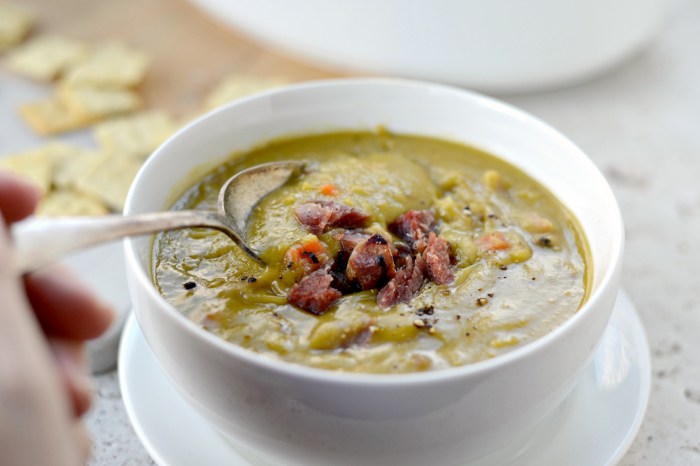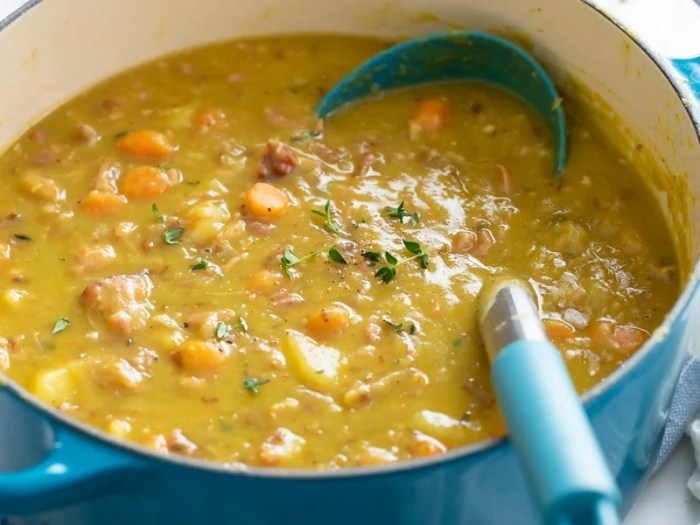Split Pea Soup with Ham: A Surabaya Teen’s Guide: Best Split Pea Soup Recipe With Ham
Best split pea soup recipe with ham – Yo, Surabaya peeps! Forget your instant noodles, we’re diving into something way more legit: split pea soup with ham. This ain’t your grandma’s soup (unless your grandma’s super cool). We’re talking a hearty, flavorful dish that’s surprisingly easy to make and perfect for a chill night in or a low-key get-together with your crew. We’ll break down everything from choosing the right ham to mastering the perfect creamy texture, so get ready to level up your culinary game.
Introduction to Split Pea Soup with Ham, Best split pea soup recipe with ham
Split pea soup, especially with ham, boasts a rich history, evolving across cultures. Think hearty peasant fare in Europe, transformed into comforting family meals worldwide. The addition of ham adds a savory depth, balancing the earthy peas. Nutritionally, it’s a powerhouse! Split peas are packed with protein and fiber, while ham contributes iron and other essential nutrients.
We’ll mainly use green split peas for this recipe—they’re widely available and cook up beautifully, offering a vibrant green hue and a slightly sweet taste. Yellow split peas are an alternative, resulting in a creamier, slightly earthier soup.
Ingredient Selection and Preparation
Choosing the right ingredients is key to a killer soup. We’ll guide you through selecting the perfect ham and prepping the other ingredients like a pro.
- Ham: A bone-in smoked ham hock is ideal. The bone adds incredible flavor to the broth, and the smokiness complements the peas perfectly. You can also use a smoked ham shank or even leftover ham bone.
- Alternative Flavor Enhancers: Think beyond the basics! Adding carrots, celery, and onions creates a classic mirepoix, boosting the umami. A splash of Worcestershire sauce or a few dashes of smoked paprika adds extra depth. Fresh thyme or bay leaf elevates the aromatics.
- Ingredient Prep:
- Rinse the split peas thoroughly.
- Chop the vegetables into roughly 1-inch pieces. Don’t stress about perfection—rustic is good.
- (Optional) Soaking the split peas for a couple of hours (or overnight) shortens cooking time and improves texture. Not mandatory, but recommended.
Cooking Methods and Techniques

Source: simplyscratch.com
Several methods can achieve split pea soup perfection. Let’s compare them:
| Method | Time | Advantages | Disadvantages |
|---|---|---|---|
| Stovetop | 1.5-2 hours | Consistent heat control, allows for easy adjustments. | Requires more hands-on attention. |
| Slow Cooker | 6-8 hours (low) | Hands-off cooking, develops deep flavors. | Longer cooking time, less control over consistency. |
| Pressure Cooker | 45-60 minutes | Fastest method, incredibly convenient. | Can be tricky to master the perfect consistency. |
For optimal texture, cook until the peas are tender but not mushy. Sautéing the vegetables before adding them to the broth enhances their flavor. Adding aromatics like bay leaf and thyme early in the cooking process infuses the soup with a complex aroma.
Variations and Flavor Profiles
Let’s spice things up with some creative twists!
- Spicy Split Pea Soup: Add a pinch of cayenne pepper or a diced jalapeño for a kick. A dash of smoked paprika adds a smoky heat.
- Creamy Split Pea Soup: Stir in a dollop of heavy cream or coconut milk at the end for extra richness. A little bit of butter adds a luxurious touch.
- Herby Split Pea Soup: Boost the freshness with a generous handful of chopped fresh herbs like parsley, chives, or dill, added just before serving.
Experiment with different spice combinations to find your perfect balance. Start with small amounts and adjust to taste. A squeeze of lemon juice can brighten the flavors and balance the richness.
Serving Suggestions and Presentation

Source: tasteofhome.com
Presentation matters, even for a casual meal! Let’s make this soup look as good as it tastes.
- Accompaniments: Crusty bread for dipping is a classic. Cornbread or a simple green salad also complements the soup beautifully.
- Presentation: Serve the soup in bowls, garnished with a swirl of cream, a sprinkle of fresh herbs (parsley or chives), and a few crispy croutons for texture. The vibrant green of the peas against the creamy white of the cream creates a visually appealing contrast. A simple garnish can elevate the overall look.
- Reheating: Gently reheat leftovers on the stovetop or in the microwave, avoiding boiling. Stir occasionally to prevent scorching.
Troubleshooting and Tips for Success

Source: thecozycook.com
Even seasoned cooks encounter hiccups. Here’s how to avoid common pitfalls.
- Soup too thick? Add a little broth or water to thin it out.
- Soup too thin? Simmer uncovered for a while to reduce the liquid. A cornstarch slurry (1 tbsp cornstarch mixed with 2 tbsp cold water) can also thicken the soup.
- Storage: Store leftovers in an airtight container in the refrigerator for up to 3-4 days. Freeze for longer storage.
Commonly Asked Questions
Can I use leftover ham bone?
Absolutely! A ham bone adds incredible depth of flavour. Just make sure to simmer it for a good while to extract all that goodness.
How long can I store leftover soup?
Leftover soup will keep in the fridge for up to 3-4 days. Always ensure it’s properly cooled before refrigerating.
What if my soup is too thick?
A hearty best split pea soup recipe with ham often benefits from rich, savory depth. For those seeking similar flavor profiles, exploring complementary dishes can enhance culinary creativity; consider checking out recipes with french onion soup for inspiration. The caramelized onions offer a similar depth of flavor that pairs beautifully with the smoky ham in a well-made split pea soup.
Simply add a little extra stock or water to thin it out to your desired consistency.
Can I freeze split pea soup?
Yes, absolutely! Freeze in airtight containers for up to 3 months. Allow to thaw completely before reheating.






